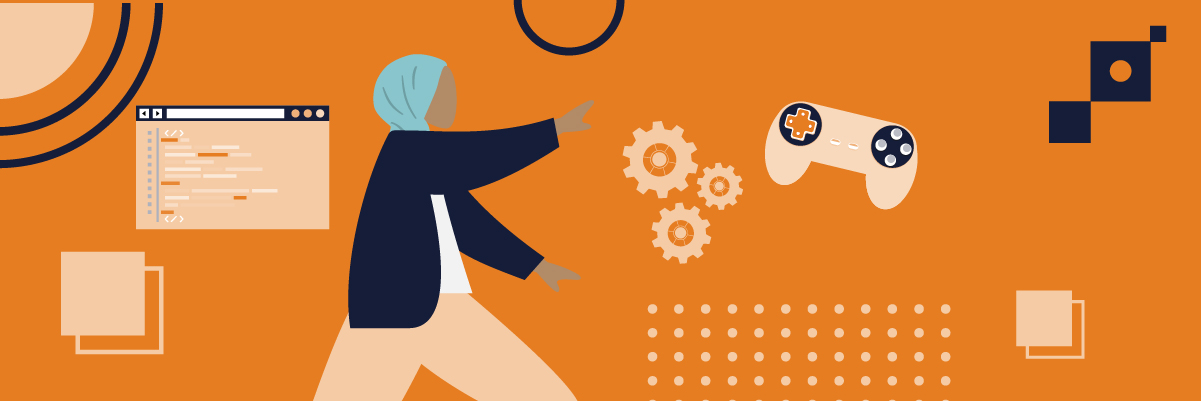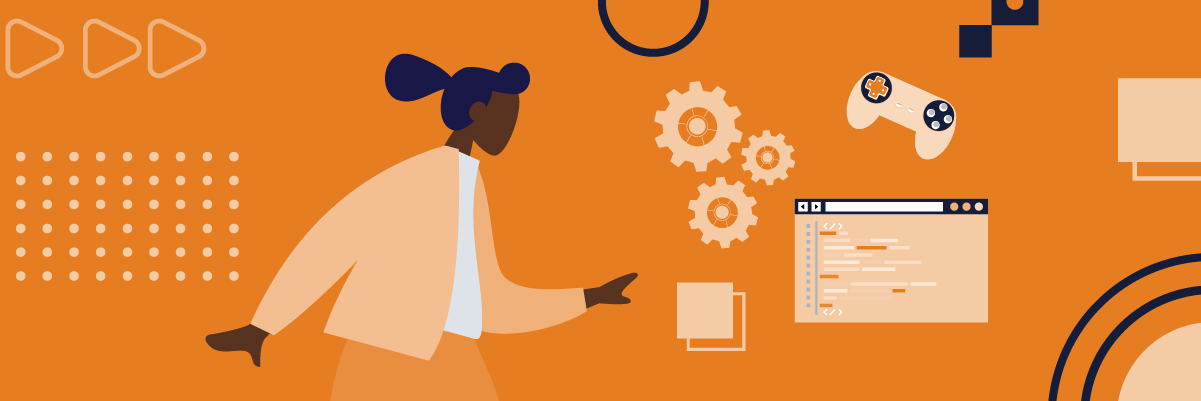Video game development is really no easy feat! There’s plenty of unseen work that goes from the first-stage prototypes to the final product. And, if you’re a first-time developer, things could get confusing fast, so you need all the help you can get. Fortunately for you, I’m here to give you the lowdown on game design and help you find quality help for the whole process.
This article will be helpful to you in several ways. First, the goal is to be able to quickly distinguish between the several stages of video game development. Second, you’ll need to identify problem areas and probable hiccups that could delay production. And third, you’ll learn about why and where to outsource work as well as when it would be a good idea to try to handle things in-house.
Having a clear view of the video game development pipeline will help you outline the whole process. Then, of course, it’s all about rolling up your sleeves and getting to work. Depending on the size and scope of your production team, that could be a pretty grand adventure in its own right; if you’re already running a medium or large-sized video game company, this is not the piece for you, mind.
But if, on the other hand, you want to take a stab at the growing indie market, you’re definitely invited to play here. Hopefully, things will look less daunting and more doable by the time you’re done reading.
Let’s press start and start the tutorial!
This post has been updated in September 2021.
The First Stage of Video Game Development: Pre-Production
It helps to visualize video game development as an industrial pipeline of sorts. This will help you manage your time and budget, and keep things on track. But, you must always remember that even the best intentions don’t always work out exactly the way you planned. Therefore, every “map” of video game development is also subject to change or alteration along the way. Don’t get discouraged by the idea, though! It’s very common to redo or redesign parts of a game after prototypes or development ideas fail. Them’s just the breaks.
So, what’s the first stage? It’s called “pre-production” and it comprises all the preparation before production per se begins. This is where you ask all of the important questions about what you intend the game to become. It’s also where the unformed idea starts to take form into a more serious project.
Here are the most important issues you’ll tackle during pre-production:
- What is the game going to be about?
- Who is the game going to be for?
- Do you have a direct competitor or competitors? If so, what’s the market look like?
- Are you going to develop your game exclusively for one platform, or is it multi-platform?
- How do you intend to sell it? Is it free-to-play with in-game purchases, available at a fixed price, or on a season-by-season subscription basis?
- What’s the estimated budget and the size of the staff?
- How long will it take to complete?
It Might Take a While
This stage has a really variable duration. It can last anywhere from a week to a year — sometimes even more — depending on the size of the game. The person who tackles the budget, staff, and monetary concerns is the video game producer. Then, you may need the services of a concept artist (like the ones who work at Bunny Studio) to create the characters and set the visual tone for the game.
But, the most important part of this process is creating the roadmap for the rest of the video game development. This is the GDD.
The Game Design Document
The Game Design Document, or GDD, establishes the intentions for the whole production. Everybody who is a part of the production should look to it as their personal video game development bible; it provides a vision of where things should be going.
The GDD establishes the:
- General concept and genre
- Story, world, and setting
- Game mechanics and gameplay
- Intended level and world design
- General art style, including character designs
This is a document you’ll be going back to time and time again during the video game development process. This also means that it’s going to be a living, breathing thing that’ll you’ll be updating over and over. Still, the core design principles and ideas should always apply. The GDD will help you stay organized, identify trouble spots before they sink the whole production, as well as understand which roles you need to hire, outsource, or do yourself.
Then, you can use the GDD to interest potential investors. And once that’s done, you can get on to prototyping!

Prototyping
CG Spectrum says the following about prototyping:
A video game prototype is a raw test that checks functionality, user experience, gameplay, mechanics, and art direction.
Prototyping happens in pre-production to test whether or not the game idea will work, and if it is worthwhile to pursue. Many ideas do not make it past this stage.
The team will often start with paper designs to test theories and work out many of the nuances of a game or a series of systems quickly, easily and cost effectively.
It’s the fastest way to see if your ideas worked when actually implemented. Also, it’s a great way to identify whether the core game concept is OK as it is or whether it needs some changes. And you won’t get there by yourself either! For this stage, you absolutely need testers who can see what you can’t in the prototype.
But, when it seems like things are reaching a desirable level, it’s on to the next stage of video game development!
Video Game Development Stage Two: Production
Now, here’s where things get good. The foundation is solid, the money’s there, and the talent’s ready. Now, you need to start applying what you know as well as the essentials of the GDD, and it’s off to the races!
Well, it could be a very slow race, depending. The production stage can typically take anything between 1 to 4 years. Some huge productions have taken more than 10 years to have a finalized product, but they’re outliers, thankfully (poor Cyberpunk 2077).
This is where:
- You’ll create all of the game assets.
- Set the gameplay rules.
- Build the world and levels.
And, of course, always keeping in mind that video game development is a living process. This means that you’ll frequently have to scrap things for others that work, look, or feel better. And this also means that you might go back and forth between the different production milestones. Don’t worry, though, it’s always three steps forward, one step back.
Now, these milestones are:
- Prototyping
- The first-playable (a more refined prototype with placeholders)
- Vertical slice; a fully playable general demonstration
- Pre-Alpha; which is a way to say “mostly there, but not quite there yet”
- Alpha; the main design and development process is done, but with plenty of QA and refinement to go. Sweeping changes are not out of the question.
- Beta; tweaking, tweaking, tweaking! Optimization is the name of the game.
- Gold; the game is ready to ship!
Key Roles
Now, you need to take into account that getting the game from A-to-Z typically requires plenty of experts firing on all cylinders. In larger companies, it’s very frequently “one job, one spot” whereas, in smaller ones, there’s plenty of multitasking involved with video game development.
Still, there are plenty of roles to occupy. To wit, they are:
- Project Manager
- Programmers (and these could specialize in many different sub-areas); These are the de facto game developers, the ones who put in the work day-in-day-out to create every aspect and asset in the game from the ground up.
- Game designers; the ones who not just program, but set the game’s flow, intention, and mechanics.
- Level designers; the magicians who make all the beautiful worlds the game’s set in.
- Game artists; anything from concept, character, level, background, modeling, is part of the eternally subdivided world of game art.
- Animators
- Visual Artists
- Audio and video engineers
- QA staff; they look for bugs and help keep the process running smoothly
- Additional roles (like writers, specific designers, translators, etc.
The Third Stage of Video Game Development: Post-Production
Think things were done after you reached gold? Wrong! There’s plenty to do after you reach all of the production milestones. Patches, bug fixing, reaching out to the community, additional marketing, server maintenance, creating new content (expansion packs, DLCs), or setting up the stage for possible sequels are all part of post-production.
This is also the stage where you assess what worked and what didn’t. Then, you can take all of your video game development lessons for future productions. At this stage, you’ll also store every asset and game doc for future use, if necessary.
Video Game Development And Quality Content
Video game development ain’t exactly easy if you don’t have the manpower. As you’ve seen, there are plenty of roles that need to be filled for every part of the process. If you’re an indie game developer, I can pretty much guarantee that you’ll need to outsource part or even all of your production to agencies and studios with the necessary know-how.
Thankfully for you, Bunny Studio is just the place. We can help with any part of the larger process of the game development, coming in at any stage of the game to help steer your production in your desired creative direction. Content by itself is not enough; you need high-quality content at every step of the way to stand out from your competitors. But hiring all of the necessary staff to complete a video game is a really tall order and one that’s probably outside the budget of most developers. Even if you’re multitasking like a champ, you’ll still need outside help.
We can help with anything and everything, and do it both extremely quickly and with fair prices.
Voice-overs? That’s our bread-and-butter! Submit a voice-over project here!
Audio post-production? No problem, just click here!
Getting your game translated for the international market? Hire a translator now!










